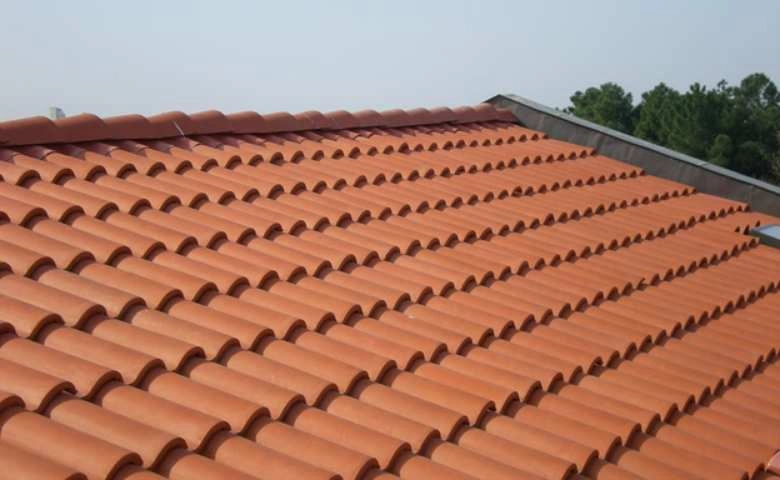Last Updated on April 4, 2024 by Admin
Tiled roofs look beautiful and durable in nature. They are also heavy and expensive, but perhaps a roofing material that can last 100 years is to be expected. Traditionally, most tiles were slate or fired clay or terracotta, but today’s roofs are stained cast concrete. The tiles can take many forms: curved, flat, ribbed or nestable, and in many styles.
Rooftop tile is an excellent choice for roofs that experience high temperatures or are exposed to salty air. That’s why tiled roofs are often seen in the Southwest, Florida coast, and California. They can also be ideal for climates where infrequent rains spill copious amounts of water in a short time. Many styles are great for removing precipitation from cloudbursts.
If you are considering using a tiled roof for your home, keep in mind that these are very heavy and cost higher than regular indoor tiles like mosaic tile. The roof frame must be structurally very strong to support the weight. We have found some advantages and disadvantages of rooftop tiles to help you make an informed decision.
Table of Contents
Advantages of Rooftop Tiles
Long-Lasting
Rooftop tiles have been shown to offer the best and longest experience in terms of durability and performance. Compared to other roofing options, like shingles, tiles are designed to provide better ventilation, natural water drainage, and better wear resistance.
Therefore, rooftop tiles can be used even in adverse weather conditions. The mass of the tiles, the technology behind the construction of the tiles, also makes them robust and ideal for roofing in different regions.
Aesthetically Attractive
Rooftop tiles are aesthetically charming. This is because of the natural sources of the mixtures and materials used in the manufacture of tiles. Some of the best sources are clay and iron oxide. These are often used in the manufacture of concrete tiles and not only make them beautiful, but they are also extremely durable.
With prolonged exposure to the sun, many roofing materials tend to discolor. However, tiles can retain their color over a long period of time with prolonged exposure to wear elements. The tiles can last more than 50 years before their colors begin to fade.
Plenty of Choices
Rooftop tiles are available in a wide range of colors, designs, and styles. You can choose a ceramic tile roof, light shades, multicolors, or settle for a black tile roof according to your personal needs. In fact, modern innovations in concrete shingles allow you to explore the most exclusive roof designs. From the Mediterranean, historical to contemporary styles, you can find a design that defines your style.
Furthermore, the tiles can be round, flat, or wavy. Some styles and designs reproduce old roofing materials. Depending on the type of roof you want, you can always have custom shingles based on your needs. The possibilities for tile roofs are practically endless.
Low Maintenance
Terracotta, concrete, and ceramic ceilings are excellent roofing materials with long service life. You don’t need to replace or redo the roof of your house after a short period of time. Many tile buildings remain functional, intact, and beautiful for many years.
On the same note, mosaics require very little maintenance under normal conditions. Additionally, maintenance is often limited to ventilation, flashing, and aluminium guttering. Shingles and other roofing materials need general maintenance that involves cleaning, painting, coating, or waterproofing the roof surface.
Environmentally Friendly
The tiles are ecological. Tile manufacturing does not lead to the depletion of natural resources. Plus, they don’t need chemical preservatives during the manufacturing and production process. Therefore, the need to close and fill landfills is greatly reduced by the long life of the tiles.
Disadvantages of Rooftop Tiles
High Cost
A clay roof system can cost two to three times more than an asphalt roof system. A clay tile roof costs, on average, between $ 675 and $ 1,400 per square (100 square feet of roof area). Concrete tile roofs are less expensive and cost between $ 400 and $ 450 per square. However, this is offset by the long life of a tiled roof. Slate tiles are more expensive, averaging between $ 1,000 and $ 4,000 per square.
Heavy Weight
Your roof construction must be able to support the weight of a tiled roof, which can be up to 850 pounds per square for clay tiles and 950 pounds per square for concrete tiles. An asphalt roof, by comparison, weighs only 225 to 325 pounds per square. If you are replacing tile roofs with shingles, you should consult an engineer to determine if structural reinforcement is needed, which will increase the cost of the roof.
Difficult Installation
Installing a tiled roof requires professional roofing contractors with extensive experience. The tiles should be measured, laid according to a specific pattern, and checked so that no moisture passes. It is not a DIY project.
Breakable
while very durable, clay, slate, and concrete tiles can break if severely impacted, such as falling tree branches, or even due to pressure from walking about them. Repairment, if necessary, can be costly.
Final Thought
With these advantages and disadvantages of tiled roofs, you can easily make informed decisions about whether a tiled roof is right for you or not. Remember that as a homeowner, you should always consider important and final considerations before installing a shingle.
In recent years, tiles were considered quite heavy and costly. However, there have been great advances in the architectural world. Therefore, you can find lightweight titles on the market that do not need expensive reinforcement.
Related Posts:
- The Benefits of Combining Rooftop Repairs with Solar Panel Installation
- What You Need to Know About TILE
- The ultimate guide to selecting a flooring material for your home
- The Best Roofing Materials for Every Climate
- Is your Home’s structure strong enough for these Shingles?


